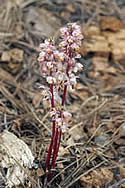- Forest Service Home
- Celebrating Wildflowers
- Home
- About Us
- News & Events
- Wildflower Viewing Areas
- Wildflower Ethics
- Forest Service Regions
- Just For Kids
- Teacher Resources
- Pollinators
- Native Gardening
- Native Plant Materials
- Invasive Plants
- Rare Plants
- Beauty of It All
- Interesting Plants
- Unique Communities
- Ethnobotany
- Special Features
- Wildflower Links
- Contact Us
USDA Forest Service Celebrating Wildflowers
|
|
|
Mycotrophic Wildflowers - From Whence They Came
Botanists believe that heterotrophic non-green plants, or heterotrophs, are evolved from closely related autotrophic green plants. Mycotrophic wildflowers are found in habitats characterized by dense overstory canopies and deep leaf litter. In these habitats of deep shade, mycotrophic wildflowers have little competition from their green cousins, who need sunlight to photosynthesize food. Botanists have learned that some green plants obtain a portion of their food through mycorrhizal fungi attached to other green plants, but can make some of their food in their own leaves. Some botanists refer to these plants as "mixotrophs" as they grow some of their food and steal some of their food. Such is the case with the wintergreens, the genus Pyrola in the heath family, Ericaceae. Ye Olde Wintergreen Curiosity ShoppeWintergreen, the genus Pyrola, has as few as seven or as many as nine species in the United States, depending on who is talking. Within the wintergreens, botanists theorize a continuum of "mixotrophy" among the species (ratio of organic carbon obtained from autotrophy and mycotrophy). This phenomenon is best seen in the Pyrola picta “complex.” Many taxonomists have recognized only one species, Pyrola picta, with a broad expression of morphological characters. Some botanists have classified one leafless form of Pyrola picta as the species Pyrola aphylla, leafless wintergreen. Pyrola aphylla is a true mycotrophic wildflower and is the only member of the genus that is a mycotroph. However, here is where the story becomes a little more curious. Leafless wintergreen has flowers that occur as two different colors. In one form, the flowers are a greenish-white, resembling the flower color of Pyrola picta. In the other form, the flowers are pink to darkish red, resembling the flower color of Pyrola asarifolia. Some botanists think that Pyrola aphylla is merely a leafless, fully mycotrophic form of P. picta and/or P. asarifolia, and not a distinct species at all. Is there a correct answer? Well, this interesting group of wintergreens will remain on the shelves of the Wintergreen Curiosity Shoppe for now. Botanists using the latest techniques are sequencing DNA and isotopes attempting to determine amounts and sources of organic carbon in this complex of wintergreens. Perhaps soon, the puzzle of these groups of wintergreens will be solved and then removed from the Old Wintergreen Curiosity Shoppe. |
|
| NOTE: PDF format links require the Adobe Acrobat Reader to view. | |
| top | Disclaimers | FOIA | Privacy Policy | Quality of Information | Photo Credits & Use |
Location: http://www.fs.fed.us/wildflowers/interesting/mycotrophic/whencetheycame.shtml
Last modified: Wednesday, 13-Oct-2010 14:32:16 EDT


